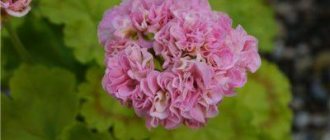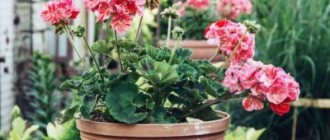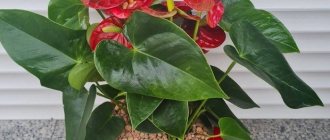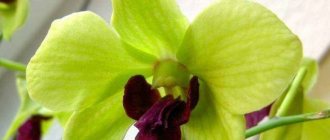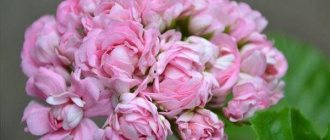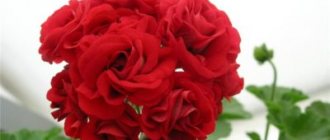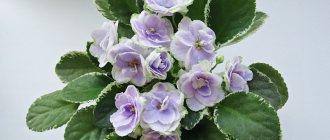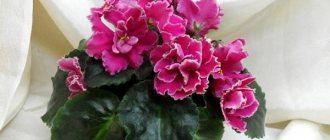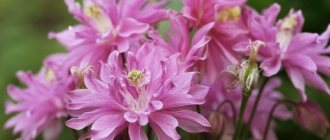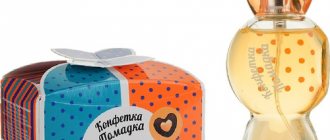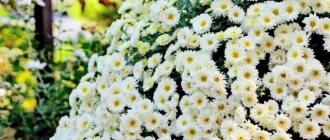History of origin
Initially, India was considered the birthplace of pelargonium, but this statement was erroneous. And all because it was delivered on European ships that sailed to the shores of India. As it turns out, South Africa is the true place where pelargonium grows . There, at the Cape of Good Hope, sailors bought exotic plants for breeders and botanists. 80% of the known pelargonium species were found in this part of the world.
In 1951, an association of amateurs and breeders called the British Pelargonium and Geranium Society was created in England, under the leadership of John Cross. Thanks to this, a new wave of popularity for pelargoniums began, and interest in marvelous flowers was revived, which continues today.
Reference. More than 100 million plants are grown and sold worldwide each year.
Varieties
What are the 11 most amazing types of geraniums that exist in nature? Description and main characteristics of the best varieties: advantages and disadvantages.
Growing Royal Violet Pelargoniums or Angels. Description and characteristics of the species, review of the best varieties. Rules for planting and care.
Growing the top 4 varieties of large-rhizome geranium in open ground: advantages and disadvantages. Secrets of planting and features of caring for the species.
Description and history of blood-red geranium. Characteristics of the 4 best varieties: advantages and disadvantages. Features of planting and care of the species.
Tulip geranium got its name due to the unusual shape of the flowers: they never open completely. Description and care of the variety.
Features of fragrant geranium and difference from other species: the best varieties. Features of care and rules of reproduction. Advantages and medicinal properties.
Description and features of the type of meadow geranium. Growing and caring for, collecting and storing plants. Medicinal properties and uses. Indications and contraindications.
The main varieties of garden geraniums. Rules for planting and caring for plants. Secrets of pelargonium propagation. How to deal with diseases and pests.
Is there a difference between geranium and pelargonium? Name and biological species. What do plants have in common and how are they different? Features of flower care.
Review of the best varieties of star pelargonium: description and characteristics of the species. Features of cultivation and care at home.
At the moment, through the efforts of breeders, hundreds of varieties of geranium have been developed. The articles in this section will help you understand their classification. What features are inherent in zonal, ampelous or succulent varieties? What is the difference between “Angels” and “Uniques”? What types of geraniums can a beginner grow, and which ones will require not only knowledge, but also practical skills? How many traits of different types can one variety contain? Which varieties will delight you with especially lush flowering, and which ones – with the wonderful aroma of their leaves? You will learn this and much more by reading the materials of our authors.
Appearance and varieties
Pelargonium is a perennial herbaceous or subshrub plant. The inflorescences have an irregular shape. Petals are white, pink, and shades of red.
The fruit is a seed capsule with sepals. The foliage is green, covered with small fibers. The leaves have a pleasant smell.
Experts in the field of botany count over 250 varieties of pelargonium, which are divided into 30 groups. Main groups :
- zonal;
- ivy-leaved;
- fragrant;
- royal;
- angels;
- unique.
Greenhouse farms in Great Britain, Belgium, Holland, and Russia are engaged in the selection of pelargonium. I would like to highlight the domestic amateur breeder Yulia Gonchar. She has the following varieties :
- Pelargonium South-Aksinya.
- South Alexandra.
- South Anisa.
- South-Giselle.
- South Yesenia.
- South Deya.
- South-Tamil.
- South Ireland.
- South Siberia.
- Yug-Eter and others.
Description of varieties of pelargonium SOUTH: what Shukar, Aksinya, Nina, Ireland, etc. look like
For many decades, pelargoniums were considered a plant of aristocrats. Very wealthy owners of villas and mansions grew it in their greenhouses and gardens. In Russia, the period of popularity of this amazing flower gave way to an era of oblivion.
Many will probably remember that there was a time when pelargonium was called nothing more than a bourgeois flower. However, years passed, and flower growers again remembered this luxurious flower, and therefore clubs for geranium lovers began to appear. Thanks to the efforts of breeders, more and more new shades and forms are appearing.
The article below will talk about the flower YUG-Shukar - pelargonium, which includes several varieties. She was bred by Yu. Gonchar.
What kind of flowers is this?
Pelargoniums of all varieties belong to the family called Geraniaceae, which unites several hundred different plant species - herbaceous, subshrubs.
Original colors, beautiful leaves, low maintenance requirements - all this is about the varieties of the YUG group
Pelargonium flowers are inflorescences in the form of umbrellas, which are characterized by a variety of shades: from snow-white to purple, burgundy and red. In this case, the colors can be either monochromatic or combined.
For your information! Pelargonium leaves are simple green, but there are also variegated varieties.
Brief description and history of selection
Amateur flower growers would never have been able to plant these amazing pelargoniums if not for Yu. Gonchar. The abbreviation that can be seen in the names of varieties is the initials of a breeder from the Voronezh region. Gonchar developed rather compact pelargoniums, which are characterized by lush flowering.
Important! All varieties, except, perhaps, YUG-Shukar, do not need shaping.
Varieties of indoor plants with names
Pelargonium PAC Viva Madeleine, Carolina and other varieties
This group of pelargoniums includes several varieties. They all differ from each other in the shape of flowers and leaves, color. The most popular varieties bred by Yu. Gonchar are described below.
SOUTH-Shukar
This spectacular variety belongs to the group of zonal pelargoniums. The flowers are ordinary or double, which have a cherry-scarlet hue. The plant needs regular pruning, otherwise it will lose its decorative shape. Pelargonium foliage is rich green.
SOUTH-Jadwiga
Pelargonium South-Jadwiga is a strong compact bush, literally strewn with bright pink flowers. The plant does not require formation; in itself it is quite neat. Jadwiga leaves are ordinary green.
SOUTH-Varvara beauty
YUG-Varvara Krasa is a pelargonium, which is called one of the most compact among those bred by Yu. Gonchar. The bush has the correct shape, it is neat and dense. It doesn't require formation. Terry buds of a delicate pink shade are more like miniature roses or peonies rather than geraniums.
The lush inflorescences of this pelargonium resemble tiny bridal bouquets
Note! If Pelargonium Varvara Krasna has enough sunny color, the color of its petals becomes brighter.
SOUTH-Sakura
It’s easy to guess that this variety got its name due to its amazing similarity to Japanese cherries. The flowers are characterized by a light pink tint, with bright crimson rays radiating from the center of each flower to the edges. The leaves are quite dense with small teeth along the edges.
SOUTH-Zlatoslava
Dwarf pelargonium Zlatoslav differs from other varieties of Yu. Gonchar in its original golden tint of foliage. The flowers are wavy and purple-pink in color.
SOUTH-Claudia
Pelargonium of this variety is called one of the most delicate. A small compact bush with rich green leaves is decorated with lush caps of white and pink buds.
Important! The plant does not need pruning.
SOUTH-Princess Grace
It is no coincidence that this flower received its royal name. Princess Gray - the true embodiment of tenderness - will take its rightful place in the collection of any gardener. A neat rose bush has rough leaves of a pleasant green hue and fairly large buds of a soft pink shade with iridescence.
YUG-Nina and others
Depending on the time of year, the color of the petals of the YUG-Deya variety changes: in summer it is salmon-pink, in spring it is white with a subtle pink blush, and in autumn it is pale pink.
Another incredibly delicate pelargonium is YUG-Nina. Golden foliage with a refined brown edge is combined with dense flowers, which are characterized by a pale pink hue and a subtle purple tone.
For your information! Pelargonium YUG-Nina was named after Grandmother Gonchar.
Pelargonium South-Kamalia belongs to the dwarf group. The variety is characterized by long flowering, lush double flowers of a pink hue. The inflorescences seem to be disheveled; they look really unusual.
White-pink pelargonium YUG-Sigal, according to gardeners, with proper care, has densely double flowers, reminiscent of mini-heads of ornamental cabbage. In direct sunlight, the flowers take on a rich pink tone.
Bright reddish-crimson tone with a white glow, long peduncles - this is the South-Aksinya pelargonium. Delicate pink color and original two-color leaves - this is the beauty of YUG-Bibigul. Pelargonium SOUTH-Ireland is a fluffy bush with snow-white inflorescences. And the pink center and white edges are a variety called YUG-Yesenia.
The pelargonium of YUG-Deya deserves special attention
In addition, today such varieties as YUG-Polina, YUG-Giselle, YUG-Tamila, YUG-Michel, YUG-Sibir, etc. are known.
How to care for YUG variety plants at home
Pelargonium Fischers Appleblossom - planting and care
Like other pelargoniums, Yu. Gonchar varieties are unpretentious. However, in order for plants to fully display all their decorative potential, it is necessary to provide them with comfortable conditions.
Illumination and temperature conditions
This culture can be classified as light-loving. Experienced gardeners recommend placing pelargoniums on the south or east side. To ensure that each side of the bush receives enough light, you should rotate it from time to time.
Excessive watering can lead to the development of diseases such as blackleg and dropsy.
In spring and summer, it is necessary to maintain the air temperature at about 20-23 °C; during the rest period, it should be about 15-17 °C.
Watering rules and humidity
The humidity level suitable for pelargoniums is 60%. In this case, the plants do not need spraying. Watering should be moderate, moisture stagnation is unacceptable.
For your information! In spring and summer, flowers need only one watering per week; in winter, SOUTH pelargoniums should be watered no more than once a decade.
Fertilizing and soil quality
The soil should be nutritious and loose. It is important that the soil is breathable. You can purchase a universal mixture in a store or make it yourself by combining equal parts:
- leaf soil;
- humus;
- turf;
- peat;
- sand.
It is recommended to apply fertilizer only in the warm months, when plants develop and form flowers. Special mineral complexes are suitable for feeding.
Flower container size
It is better to choose a small container for pelargoniums of the group under consideration, otherwise the plant may stop flowering. Additionally, these flowers will hold their shape better in smaller containers or pots.
Pruning and replanting
Pelargoniums need sanitary pruning annually. It is best to carry out this procedure in March. Trimming must be done diagonally, using a sharp knife.
The best option for pelargoniums are clay pots with a drainage layer on the bottom.
Note! These plants do not like transplants, and therefore the container and soil for plants should not be changed more than once every couple of years.
Features of plant flowering
Pelargonium Millfield Rose (Milfield Rose)
Features of plant care and its appearance differ depending on the period of time.
Period of activity and rest
During the winter months, South Pelargoniums are dormant. At this time, it is recommended to move the containers with them to a cool, frequently ventilated room and reduce watering. The plant should be in this state from November to February. In spring, a period of active growth begins. The plant requires a lot of strength, and therefore it is important to fertilize and moisten it in a timely manner.
Types and shape of flowers
Yu. Gonchar pelargonium flowers differ in color and shape. The color can be white, rich red, delicate or bright pink. As for the forms, there are such pelargoniums as:
- simple. Their petals are arranged in one row;
- semi-double. Each flower has two or three rows of petals;
- terry. Pelargoniums are characterized by the presence of several rows of petals.
Flower propagation methods
Pelargoniums can be propagated either by cuttings or by dividing the bush.
When the plant fades, it is necessary to cut off the stem, which has at least three leaves. It should be immersed in water, and when the roots appear (usually this happens after 14-17 days), the plant should be planted in a prepared container.
When propagating by dividing the bush, you should remove the plant from the pot, carefully remove the soil from the roots and divide them. At least two or three buds should remain on each part of the pelargonium. The resulting bushes will remain planted in separate containers.
Growing problems, diseases and pests
Flower growers say: pelargoniums of the SOUTH group are distinguished by strong immunity. However, sometimes they are affected by diseases such as:
- root rot;
- gray mold;
- rust.
The probability of plants being damaged by caterpillars, slugs and aphids is quite high.
How to deal with them
For prevention purposes, plants should be treated with antifungal drugs. If the disease begins to progress or pests are found on the flowers, it is recommended to use fungicides.
Important! Those parts that have been damaged by insects or disease should be removed.
From all of the above, it is easy to understand that Yu. Gonchar’s pelargoniums allow you, with minimal care, to get a spectacular and bright indoor plant that will delight the eye for a long time, become an original interior decoration, and add bright colors even to a boring space.
Source: https://greensotka.ru/tsvetushchie/yug-shukar-pelargoniya.html
Care
Pelargonium Denise - a popular variety
Pelargonium SOUTH Shukar needs the right conditions. The abundance of flowering and the lifespan of the flower depend on this.
Important! If you deviate from the recommendations, the geranium may stop blooming.
Factors required to grow a flower:
- Illumination is diffused light; during the flowering period, the duration of daylight is at least 8 hours.
- Temperature – in the warm season – 23 °C, in the winter – 15 °C.
- Watering – during the flowering period, the plant is watered once a week, as stagnation of moisture leads to the development of gray rot. In winter, the amount of watering is reduced to once every 10 days. The humidity level is maintained at 60%. SOUTH Segal pelargonium and others do not need spraying.
- Fertilizing – during flowering, add a universal remedy for flowering plants once a week. The soil should be loose and nutritious.
- The size of the pot is 1 cm larger than the earthen ball.
- Pruning - dwarf varieties do not need to form stems; taller specimens can be pinched out in the spring. Transplantation is carried out once a year.
Description and photos of species of Yu. Gonchar’s own selection
Below is a detailed description and photo of the varieties Shukar, Varvara Krasa, Nina, Kamalia.
Nina
Plants of the species are zonal, dwarf in size . Flowers with densely double petals, pale pink with a soft purple tint. A lush compact bush easily forms on its own. The stem and peduncles are dense, fleshy, directed upward. The inflorescences are shaped like roses. The foliage color is golden with a brown edge.
This variety of pelargonium got its name in honor of grandmother Yulia Gonchar. The price of a rooted cutting is 1000-1500 rubles.
Shukar
This species also belongs to the zonal species. Standard size, requires shaping. Inflorescences are scattered in different directions. Shades: cherry, scarlet, dark red with tints. The texture of the flowers is semi-double and simple, large in size. The shape of the petals is slightly elongated. The name "Shukar" translated from the Gypsy language means "beauty" . The price of a rooted cutting varies from 1000-1200 rubles.
Varvara Krasa
An upright zonal plant, dwarf in size. The bush is dense, dense, easy to form, and has regular growth. The flowers are large, double, light pink. In the sun it takes on a deeper pink hue. Pelargonium blooms profusely and for a long time. You can buy rooted cuttings for 500-700 rubles apiece.
Kamalia
Zonal flower, dwarf size. The bush is branched, the foliage is green. The inflorescences have an original shape, slightly shabby. The color is soft pink, gradually turning to rich. The texture of the flowers is terry. The variety is distinguished by long-lasting flowering, even in winter. The cost of one cutting is 700-1000 rubles.
Varieties
Pelargonium ivy - home care
The YUG group currently includes many varieties. They have different colors, and this allows collectors to show interest in new species. The shades of some varieties of pelargonium change during flowering. For example, like YUG Varvara-Kras’s pelargonium.
Geranium variety with double-colored petals
Popular varieties:
- SOUTH Shukar - rich burgundy color of the petals, size about 50 cm, requires the formation of a crown.
- SOUTH Jadwiga pelargonium - flowers are soft pink, do not require pruning, green leaves. Average height 40 cm.
- SOUTH Sakura - the name comes from the plant of the same name. The center of the flower is crimson, the rest is light pink. The leaves are serrated.
- Pelargonium Varvara-Krasa is a dwarf size, height does not exceed 30 cm. Double flowers are similar in shape to peonies. Color white-pink. Blooms for a long time.
- SOUTH Zlatoslava - Bright pink inflorescences. The leaves are green with a slight tint of gold.
- SOUTH Claudia - snow-white, double flowers, plant size is dwarf, crown formation is not required.
- SOUTH Princess Grace is an original variety. The white petals are edged with a dark pink border.
- Pelargonium SOUTH Ireland - flowers are white, sometimes greenish in the middle and outside of the petals. Does not require the formation of a bush.
- SOUTH Yesenia - pink flowers with reddish veins, the edges of the petals are pinkish-white.
- SOUTH Nina - golden foliage. The flowers are densely double, pale lilac-pink. The bush forms independently.
How and where to plant?
The container for pelargonium is chosen to have a small diameter. Compact flower bushes will hold their shape better in them; flowering also directly depends on the size of the flowerpot . The plant refuses to bloom in large pots. Material for the container, preferably clay. A drainage layer of at least 2 cm thick is required.
- The plant should be placed in a pot carefully; the root system is fragile.
- Then carefully sprinkle it with earth without compacting it.
- Moisten the top a little with warm, settled water.
Lighting
You need a lot of light. The plant loves sun and bright light. Preference should be given to window sills on the south side. However, if there is poor ventilation, it may overheat, in which case you need to temporarily darken it. With a lack of sunlight, the leaves turn yellow and the lower ones dry out. For an evenly lush crown, the flower must be regularly turned to the sun, first on one side, then on the other.
The soil
For planting and replanting, the soil needs to be loose, breathable, and enriched with minerals. Soil for pelargonium can be purchased ready-made at garden stores . Or cook it yourself.
The composition of this soil mixture is: leaf soil, peat or compost humus, sand. All components must be in equal proportions.
For safety precautions, it is better to ignite the components of the mixture for 30 minutes. You can also add perlite as a soil loosener.
How to care for YUG variety plants at home
Pelargonium Elnaryds Hilda and other varieties of the Elnaruds series
Like other pelargoniums, Yu. Gonchar varieties are unpretentious. However, in order for plants to fully display all their decorative potential, it is necessary to provide them with comfortable conditions.
Illumination and temperature conditions
This culture can be classified as light-loving. Experienced gardeners recommend placing pelargoniums on the south or east side. To ensure that each side of the bush receives enough light, you should rotate it from time to time.
Excessive watering can lead to the development of diseases such as blackleg and dropsy.
In spring and summer, it is necessary to maintain the air temperature at about 20-23 °C; during the rest period, it should be about 15-17 °C.
Watering rules and humidity
The humidity level suitable for pelargoniums is 60%. In this case, the plants do not need spraying. Watering should be moderate, moisture stagnation is unacceptable.
For your information! In spring and summer, flowers need only one watering per week; in winter, SOUTH pelargoniums should be watered no more than once a decade.
Fertilizing and soil quality
The soil should be nutritious and loose. It is important that the soil is breathable. You can purchase a universal mixture in a store or make it yourself by combining equal parts:
- leaf soil;
- humus;
- turf;
- peat;
- sand.
It is recommended to apply fertilizer only in the warm months, when plants develop and form flowers. Special mineral complexes are suitable for feeding.
Flower container size
It is better to choose a small container for pelargoniums of the group under consideration, otherwise the plant may stop flowering. Additionally, these flowers will hold their shape better in smaller containers or pots.
Pruning and replanting
Pelargoniums need sanitary pruning annually. It is best to carry out this procedure in March. Trimming must be done diagonally, using a sharp knife.
The best option for pelargoniums are clay pots with a drainage layer on the bottom.
Note! These plants do not like transplants, and therefore the container and soil for plants should not be changed more than once every couple of years.
Conditions for growing indoor flowers
Pelargonium is an undemanding indoor flower . However, for a healthy and beautiful appearance, comfortable conditions are important for the plant.
- An indoor flower should be watered abundantly, but at the same time the water should not stagnate in the pot. Watering is needed abundantly, daily, especially in hot weather. In winter, you don’t need to water much, but you should not let the soil dry out completely. If watering is abundant, traces of gray rot appear on the leaves, and sometimes the stem rots, which can lead to the loss of the plant. If you water little, the flower withers, the leaves begin to turn yellow and dry out.
- Air humidity is not particularly important for pelargonium; on the contrary, excess moisture and stagnant air can cause fungal diseases of the flower. Spraying should not be done.
- In the warm season, the optimal temperature is +18 -22 C°. Sufficiently high air temperatures, especially indoors, will also negatively affect the plant.
- In winter, pelargonium is in a state of sleep. Plants should be moved to a room with a temperature of +12°C and regular ventilation. This could be a loggia, balcony, greenhouse. Watering should be sparse. Wintering lasts approximately from November to February. At the end of winter, pelargonium begins to gradually wake up.
- Replanting and pruning. These procedures should be performed annually, preferably in the spring, in mid-March. In order for the plant to have a lush appearance, it is necessary to trim the pieces. Perform this procedure only with a sharp knife diagonally. Broken parts of the plant may be affected by rot. And to enhance growth and branching, shoots are pinched.
- To ensure adequate nutrition, the flower needs to be fed and organic fertilizers applied. But it is important to dose the fertilizer and follow all the instructions indicated on the packaging:
- Feed “Mr. Color” Saintpaulia during or before flowering with 1 capful per 1 liter of water.
- "Gilea" - recommended concentration is 2 caps per 1 liter.
- “Fertimix” vermicompost for flowering plants, 3 caps per 1 liter, apply once every 10-14 days.
Important. Use only clean water at room temperature.
Adding nutrients is prohibited in hot weather. In this case, the plant will suffer stress.
- First, you should move it to a cool place.
- Next, be sure to water the flower, otherwise fertilizers may burn the roots.
Most of all, the plant needs additional nutrition in summer and spring. Therefore, you need to feed until the beginning of September, approximately once every 2 weeks . You should not feed a transplanted or just purchased plant; you need to wait at least 1 month. It is also not recommended to use mineral fertilizers for sick flowers with damaged root systems.
Pelargoniums South: features of varieties and cultivation
SOUTH Shukar pelargonium is one of the popular varieties. The rich burgundy inflorescences are attractive due to their large size. They stand out effectively against the green background.
Description
Russian breeder Yulia Gonchar gave the world many varieties of geranium.
The plant attracts with its rich color
Unlike other varieties, representatives of the YUG group have a compact size and beautiful flowering.
A brief history of the appearance of flowers of the YUG group
India has long been considered the birthplace of pelargoniums, but only recently have scientists been able to establish the exact origin of the plant. It originally appeared in South America.
Active selection began in 1951 in England. Amateurs and experienced flower growers grew new varieties, achieving improved flower characteristics.
Yulia Gonchar (YUG) was no exception. She wanted to get compact geraniums that would have large inflorescences. Over time, the breeder's work was successful, and she created many new plants.
For example, pelargonium SOUTH Aksinya has double inflorescences of a delicate red color with a barely noticeable white center. The small size of the specimens allows them to be kept in apartments and tiny rooms. The dwarf size does not make pelargonium unattractive; on the contrary, at such a height the plants’ inflorescences look impressive.
Varieties
The YUG group currently includes many varieties. They have different colors, and this allows collectors to show interest in new species. The shades of some varieties of pelargonium change during flowering. For example, like YUG Varvara-Kras’s pelargonium.
Geranium variety with double-colored petals
- SOUTH Shukar - rich burgundy color of the petals, size about 50 cm, requires the formation of a crown.
- SOUTH Jadwiga pelargonium - flowers are soft pink, do not require pruning, green leaves. Average height 40 cm.
- SOUTH Sakura - the name comes from the plant of the same name. The center of the flower is crimson, the rest is light pink. The leaves are serrated.
- Pelargonium Varvara-Krasa is a dwarf size, height does not exceed 30 cm. Double flowers are similar in shape to peonies. Color white-pink. Blooms for a long time.
- SOUTH Zlatoslava - Bright pink inflorescences. The leaves are green with a slight tint of gold.
- SOUTH Claudia - snow-white, double flowers, plant size is dwarf, crown formation is not required.
- SOUTH Princess Grace is an original variety. The white petals are edged with a dark pink border.
- Pelargonium SOUTH Ireland - flowers are white, sometimes greenish in the middle and outside of the petals. Does not require the formation of a bush.
- SOUTH Yesenia - pink flowers with reddish veins, the edges of the petals are pinkish-white.
- SOUTH Nina - golden foliage. The flowers are densely double, pale lilac-pink. The bush forms independently.
Pelargonium SOUTH Shukar needs the right conditions. The abundance of flowering and the lifespan of the flower depend on this.
Important! If you deviate from the recommendations, the geranium may stop blooming.
Factors required to grow a flower:
- Illumination is diffused light; during the flowering period, the duration of daylight is at least 8 hours.
- Temperature – in the warm season – 23 °C, in the winter – 15 °C.
- Watering – during the flowering period, the plant is watered once a week, as stagnation of moisture leads to the development of gray rot. In winter, the amount of watering is reduced to once every 10 days. The humidity level is maintained at 60%. SOUTH Segal pelargonium and others do not need spraying.
- Fertilizing – during flowering, add a universal remedy for flowering plants once a week. The soil should be loose and nutritious.
- The size of the pot is 1 cm larger than the earthen ball.
- Pruning - dwarf varieties do not need to form stems; taller specimens can be pinched out in the spring. Transplantation is carried out once a year.
Features of periods of development
The plant has two periods of time in the year - dormancy and active growth. They must be changed periodically, otherwise the geranium will not live long.
Periods
Growth time is in spring and summer. Around mid-April, pelargonium awakens from hibernation and begins to grow. At this time, bud formation and flowering occur.
! Some varieties of geraniums bloom for a very long time (even in winter), for example, YUG Kamalia pelargonium.
In spring, geraniums form buds
Preparation for dormancy begins around September. During this period, the plant is not replanted, fed or rearranged. It is advisable to reduce the temperature, the amount of watering and the length of daylight hours.
Geraniums awaken gradually. To do this, they are gradually returned to their usual conditions of detention, imitating the change of seasons in nature.
Types of flowers
The varieties differ not only in size and color. Pelargonium SOUTH Deya, for example, has double petals - this makes the flowers voluminous, lush, and beautiful. They are called terry.
Varieties may have different flower shapes. For example, in tulip pelargonium they resemble tulips. This also applies to rosebud species. Deacons look especially beautiful. This geranium has flowers collected in a small bouquet.
Reproduction methods
The easiest way to propagate pelargonium is by cuttings. To do this, just cut the stalk, put it in water or plant it in the ground. It takes 2-3 weeks for the roots to germinate, after which the plant needs to be cared for as usual.
Important! During flowering, branches cannot be cut, as the wound will negatively affect the health of the flower.
Additionally, you can use stimulants for the development of the root system, for example, “Kornevin”. It is better to do this in the spring, when the geranium is gaining strength.
Another breeding option is using seeds, which are sold in specialized stores. They are planted in March in shallow containers. The first shoots appear at 3-4 weeks, picking is carried out at 6 weeks after sowing. This method of growing is difficult for indoor conditions.
Diseases and pests
When the soil is over-moistened, gray rot appears, which is easy to visually detect by characteristic spots. The affected parts are removed and the plant is treated with a fungicide.
When the air is dry, rust appears on the leaves of pelargonium. Treatment is the same as for gray rot. The disease can be identified by a characteristic brown coating on the leaves.
When there is a lack of air humidity, the plant is affected by spider mites. Its presence is determined by the characteristic web on geraniums. To kill the pest, the entire plant is sprayed with an insecticide.
Aphids are also easy to see visually. It attaches to the outside of the leaf and stems. Insects are carefully cleaned with a cotton swab, and the geranium is washed with soapy water and treated with an insecticide.
The description of a variety does not always give a complete picture of the characteristics of a particular pelargonium. Carefully study the care recommendations, this will help preserve the plant for many years.
Varieties
What are the 11 most amazing types of geraniums that exist in nature? Description and main characteristics of the best varieties: advantages and disadvantages.
Growing Royal Violet Pelargoniums or Angels. Description and characteristics of the species, review of the best varieties. Rules for planting and care.
Growing the top 4 varieties of large-rhizome geranium in open ground: advantages and disadvantages. Secrets of planting and features of caring for the species.
Description and history of blood-red geranium. Characteristics of the 4 best varieties: advantages and disadvantages. Features of planting and care of the species.
Source: https://sp-smena.ru/tsvety/komnatnye-tsvety/pelargonii-yug-osobennosti-sortov-i-vyrashhivaniya.html
Reproduction methods
Cuttings
At the end of flowering, the tops of the pelargonium are cut off. The top 3 leaves are left, the others are removed.- Sections must be treated with fungicide, ash or activated carbon. This is done so that the stem of the mother plant does not rot.
- Then the cuttings are placed in transparent glasses with drainage, coke fiber or coarse sand is placed in them, and liquid is poured in.
Another option is to place the cuttings in a container with water and, as they dry, it needs to be added.
Roots appear quite quickly, after 10-12 days . The temperature in the room must be maintained at least +20°C. After this, the rooted cuttings are planted in previously prepared soil in a permanent place, where they continue to develop.
Next, you can watch a video that talks about cuttings:
Dividing the bush
If the bush has grown, you can divide it. The best time for this is spring, when the plant is replanted and the soil is renewed.
- First of all, remove the flower from the pot and shake off excess soil.
- Then they carefully examine his kidneys.
- The area with healthy kidneys is separated and transplanted into another container.
Diseases and harmful insects
Pelargonium is resistant to various diseases and pests . But they still occur:
- Gray mold is a disease that affects leaves. You need to fight it in the following way: remove damaged leaves, stop watering the plant, put it in the sun, spray it with an antifungal agent.
- Rot of the root collar of a flower develops with excess moisture. This phenomenon turns out to be detrimental to pelargonium.
- Rust appears as yellow spots on the bottom of the leaf.
Disease prevention is to treat plants with antifungal solutions before wintering. They are also sprayed with fungicide products, the drug “Doctor Foley” for fungi. The affected parts of the plant must be removed. Among insects, the main pests are whiteflies, aphids, mites, thrips, and mealybugs.
Advice. Before buying a flower, carefully inspect it; you can infect other healthy plants. They are treated with products with insectoacaricidal properties, for example “Doctor Foley” against parasites.
What other famous varieties of pelargonium are there? Read about Richard Hudson, Prince Gustav, April Snow, Star-shaped, Milfeed Rose, Australian Pink Rosebud, Anita, Rococo, Grandiflora, Red Pandora.
Growing pelargonium at home is not at all difficult . Especially if you follow the basic rules for caring for the plant. Then the flower will grow and smell fragrant for joy.
general description
Pelargoniums are part of the Geranium family. It unites several hundred plant species. These are both subshrubs and herbaceous specimens. Only a few types of pelargonium are grown at home. But even so, the choice is very wide.
Flowers have a variety of colors. They form small or large inflorescences in the form of umbrellas. White, soft and bright pink, red, burgundy, purple and other expressive tones leave no one indifferent. The colors can be either monochromatic or combined. The leaves are simple but beautiful. They are usually green, but there are other options, including variegated ones. Plants are perennial.
Pelargoniums of the YUG series are the creations of the wonderful breeder Yulia Gonchar from the Voronezh region. Actually, the large letters in the names of the varieties actually mean the initials of the creator. All varieties bred by Julia bloom readily and profusely. The bushes are usually compact and fluffy. The exception is YUG-Shukar, which is of average height and requires shaping.
